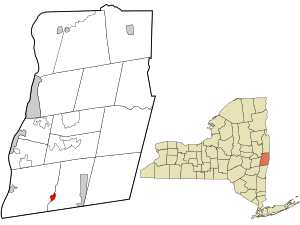Nassau (village), New York facts for kids
Quick facts for kids
Nassau, New York
|
|
|---|---|
|
Village
|
|

Location in Rensselaer County and the state of New York.
|
|
| Country | United States |
| State | New York |
| County | Rensselaer |
| Government | |
| • Type | Incorporated Village |
| Area | |
| • Total | 0.70 sq mi (1.81 km2) |
| • Land | 0.70 sq mi (1.81 km2) |
| • Water | 0.00 sq mi (0.00 km2) |
| Elevation | 404 ft (123 m) |
| Population
(2020)
|
|
| • Total | 1,103 |
| • Density | 1,577.97/sq mi (609.48/km2) |
| Time zone | UTC-5 (Eastern (EST)) |
| • Summer (DST) | UTC-4 (EDT) |
| ZIP code |
12123
|
| Area code(s) | 518 |
| FIPS code | 36-49506 |
| GNIS feature ID | 0958278 |
Nassau is a small village in Rensselaer County, New York, United States. It is part of the larger Town of Nassau. In 2020, about 1,103 people lived there.
The Village of Nassau is located in the southern part of Rensselaer County. A small part of the village also extends into the Town of Schodack. Nassau is about 15 miles east of Albany, which is the capital city of New York State.
Contents
History of Nassau Village
The area where Nassau Village is located was first settled around 1760. The community was first known as "Union Village." Later, it was called "Schermerhorn's Village" when it officially became a village in the 1800s. After some time, it stopped being an official village, but then it gained its village status back and became known as Nassau Village.
Some important historical places in Nassau are listed on the National Register of Historic Places. These include the Albany Avenue Historic District, the Chatham Street Row, and the Church Street Historic District. These places help protect the village's history and old buildings.
Where is Nassau Located?
Nassau is located at coordinates 42.5152 degrees north latitude and -73.6111 degrees west longitude.
The United States Census Bureau reports that the village covers a total area of about 0.7 square miles (1.8 square kilometers). All of this area is land, meaning there are no large bodies of water like lakes or rivers within the village limits.
Nassau's Population Over Time
| Historical population | |||
|---|---|---|---|
| Census | Pop. | %± | |
| 1870 | 348 | — | |
| 1880 | 449 | 29.0% | |
| 1890 | 356 | −20.7% | |
| 1900 | 418 | 17.4% | |
| 1910 | 529 | 26.6% | |
| 1920 | 655 | 23.8% | |
| 1930 | 670 | 2.3% | |
| 1940 | 698 | 4.2% | |
| 1950 | 952 | 36.4% | |
| 1960 | 1,248 | 31.1% | |
| 1970 | 1,466 | 17.5% | |
| 1980 | 1,285 | −12.3% | |
| 1990 | 1,254 | −2.4% | |
| 2000 | 1,161 | −7.4% | |
| 2010 | 1,133 | −2.4% | |
| 2020 | 1,103 | −2.6% | |
| U.S. Decennial Census | |||
The population of Nassau has changed over the years. In 1870, there were 348 people. The population grew steadily for many decades, reaching its highest point in 1970 with 1,466 residents. Since then, the number of people living in Nassau has slowly decreased. In 2020, the population was 1,103.
People and Households in Nassau
In 2000, there were 1,161 people living in Nassau. These people lived in 490 households, and 321 of these were families. The village had about 1,705 people per square mile.
- About 31.6% of households had children under 18 living with them.
- Nearly half (48.6%) of the households were married couples living together.
- About 13.1% of households were headed by a female with no husband present.
- Around 29.0% of all households were made up of people living alone.
- About 12.4% of households had someone aged 65 or older living alone.
The average household had 2.37 people, and the average family had 2.92 people.
Age Groups in Nassau
The population in Nassau is made up of people of different ages:
- 24.4% were under 18 years old.
- 6.9% were between 18 and 24 years old.
- 29.5% were between 25 and 44 years old.
- 25.4% were between 45 and 64 years old.
- 13.9% were 65 years or older.
The median age in the village was 38 years old. This means half the people were younger than 38 and half were older. For every 100 females, there were about 89.1 males.
See also
 In Spanish: Nassau (villa) para niños
In Spanish: Nassau (villa) para niños


